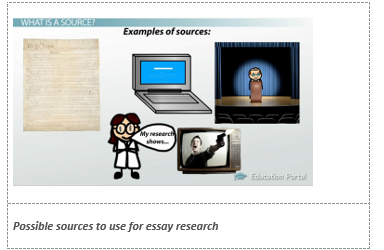When writing an essay, you will often be asked to utilize appropriate sources for evidence, including facts and definitions. In this video, we will talk about the ways we can utilize and evaluate sources and evidence.
Sifting Through the Information Age
Thankfully, when it comes to writing essays, we are not expected to know all facts, figures and information off the top of our head. Not only are we encouraged to use outside sources, we are expected to use them. However, in the Information Age, we can be overrun with information. So how do we determine if a source is a good source, and how do we use that information in our essay?
What Is a Source?
A source is the place where you gained information used in your writing. A source can be a printed document, an online document, a speech, a quote or even a television or radio program. The best sources are those in which your reader can go back and verify for themselves the information you utilized. There are two types of sources: primary and secondary. A primary source is the original place in which the information can be found, or the first person to make that information available. A secondary source is a source that simply relates information that was originally produced by someone else or somewhere else. In academic writing, it is best to use primary sources whenever possible.
Evaluating Evidence from a Source

In your research, you will find that sources don't always agree. If there is disagreement around facts, figures, definitions or statistics, you will need to determine which one is the correct piece of information for your topic. In order to do this, you need to evaluate the evidence from the sources. There are several ways to evaluate evidence. One way is to determine which set of information has been duplicated with similar results. So if one study says people turn blue when eating too much cotton candy and another one says people don't change color no matter how much cotton candy they eat, you will need to find yet another source that has done similar research to the two. If you find that additional studies have, in fact, had results where people turned blue after eating large amounts of cotton candy, go with your original study. However, you should also cite those duplicating studies so that the reader knows that you didn't randomly choose which author was correct by simply playing rock-paper-scissors.
Another way to evaluate evidence is to ask: how current is the information? Some statistics are true at a point in time, but those numbers don't stay constant. For instance, for a point in time, Nintendo 64 was the most popular video gaming system in the United States. You can find that information that states this as a fact. The research was sound and done well. However, if you use that as a source on the most popular gaming system in the country today, your reader will be correct in thinking you didn't do very good research. So, for facts, figures, statistics and even some definitions, more recent sources tend to be better for supplying current data, while earlier sources are great for providing historical information.
Another important piece of information you want is how information was gathered to determine things like statistics - especially population statistics. For instance, if you read an article that says 'snails are considered quite a delicacy here, with over 40,000 tons eaten per year,' it would be good to look and see that the article was referring to France, not the United States. You cannot generalize information beyond the population that was used in the original research. This means you have to make sure you always read the methods section in a study, which is where demographics of the research participants can be found.